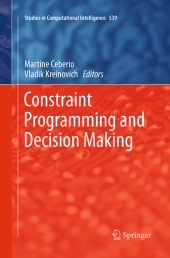 Neuerscheinungen 2016Stand: 2020-02-01 |
Schnellsuche
ISBN/Stichwort/Autor
|
Herderstra▀e 10
10625 Berlin
Tel.: 030 315 714 16
Fax 030 315 714 14
info@buchspektrum.de |

Martine Ceberio, Vladik Kreinovich
(Beteiligte)
Constraint Programming and Decision Making
Herausgegeben von Ceberio, Martine; Kreinovich, Vladik
Softcover reprint of the original 1st ed. 2014. 2016. xii, 209 S. 33 SW-Abb. 235 mm
Verlag/Jahr: SPRINGER, BERLIN; SPRINGER INTERNATIONAL PUBLISHING 2016
ISBN: 3-319-38202-0 (3319382020)
Neue ISBN: 978-3-319-38202-9 (9783319382029)
Preis und Lieferzeit: Bitte klicken
This book presents extended versions of select papers from annual International Workshops on Constraint Programming and Decision Making from 2008 to 2012. It covers all stages of decision making under constraints.
In many application areas, it is necessary to make effective decisions under constraints. Several area-specific techniques are known for such decision problems; however, because these techniques are area-specific, it is not easy to apply each technique to other applications areas. Cross-fertilization between different application areas is one of the main objectives of the annual International Workshops on Constraint Programming and Decision Making. Those workshops, held in the US (El Paso, Texas), in Europe (Lyon, France) and in Asia (Novosibirsk, Russia), from 2008 to 2012, have attracted researchers and practitioners from all over the world. This volume presents extended versions of selected papers from those workshops. These papers deal with all stages of decision making under constraints: (1) formulating the problem of multi-criteria decision making in precise terms, (2) determining when the corresponding decision problem is algorithmically solvable; (3) finding the corresponding algorithms and making these algorithms as efficient as possible and (4) taking into account interval, probabilistic and fuzzy uncertainty inherent in the corresponding decision making problems. The resulting application areas include environmental studies (selecting the best location for a meteorological tower), biology (selecting the most probable evolution history of a species), and engineering (designing the best control for a magnetic levitation train).
Algorithmics of Checking Whether a Mapping Is Injective, Surjective,
and/or Bijective.-
Simplicity Is Worse Than Theft: A Constraint-Based Explanation of a
Seemingly Counter-Intuitive Russian Saying.-
Continuous If-Then Statements Are Computable.-
Linear programming with Interval Type-2 fuzzy constraints.-
Epistemic Considerations on Expert Disagreement, Normative
Justification, and Inconsistency Regarding Multi-Criteria Decision Making .-Interval Linear Programming Techniques in Constraint Programming
and Global Optimization.-Selecting the Best Location for a Meteorological Tower: A Case Study
of Multi-Objective Constraint Optimization.-Gibbs Sampling as a Natural Statistical Analog of Constraints
Techniques: Prediction in Science under General Probabilistic Uncertainty .-Why Tensors.-Adding Constraints - A (Seemingly Counterintuitive but) Useful
Heuristic in Solving Difficult Problems.-Under Physics-Motivated Constraints, Generally-Non-Algorithmic Computational Problems Become Algorithmically Solvable.-
Constraint-Related Reinterpretation of Fundamental Physical
Equations Can Serve as a Built-In Regularization.-
Optimization of the Choquet Integral using Genetic Algorithm .-
Optimization of the Choquet Integral using Genetic Algorithm .-
Scalable, Portable, Verifiable Kronecker Products on Multi-Scale
Computers.-
Reliable and
Robust Synthesis of QFT controller using ICSP.-
Towards an Efficient Bisection of Ellipsoids .-
.-An Auto-validating Rejection Sampler for Differentiable Arithmetical
Expressions: Posterior Sampling of Phylogenetic Quartets.-
Graph Subdivision Methods in Interval Global Optimization .-
An Extended BDI-Based Model for Human Decision-Making and Social
Behavior: Various Applications .-
Why Curvature in L-Curve: Combining Soft Constraints .-
Surrogate Models for Mixed Discrete-Continuous Variables
Why Ellipsoid Constraints, Ellipsoid Clusters, and Riemannian
Space-Time: Dvoretzky┤s Theorem Revisited


